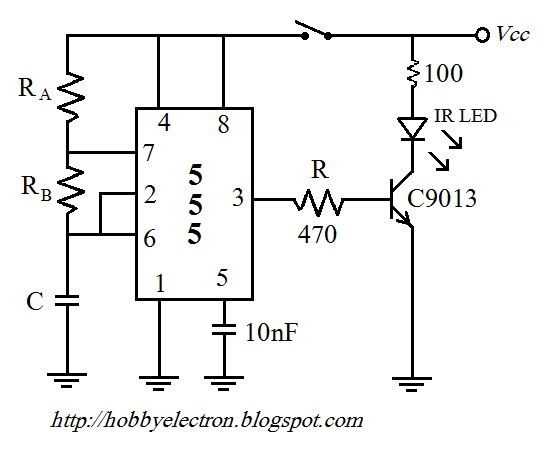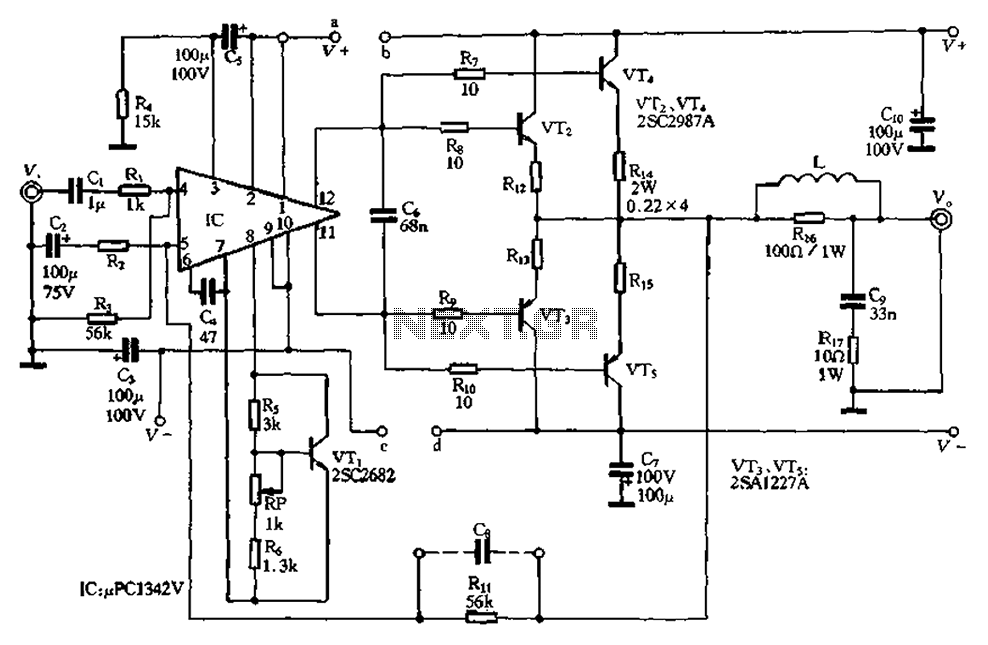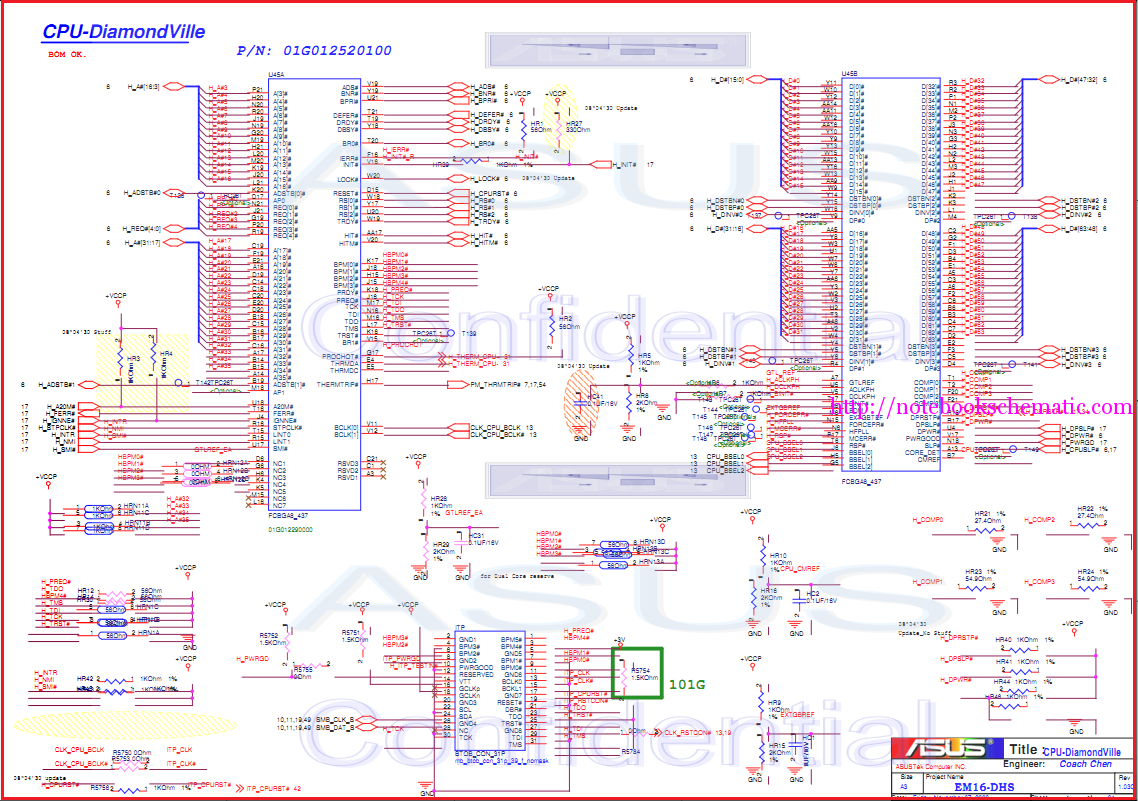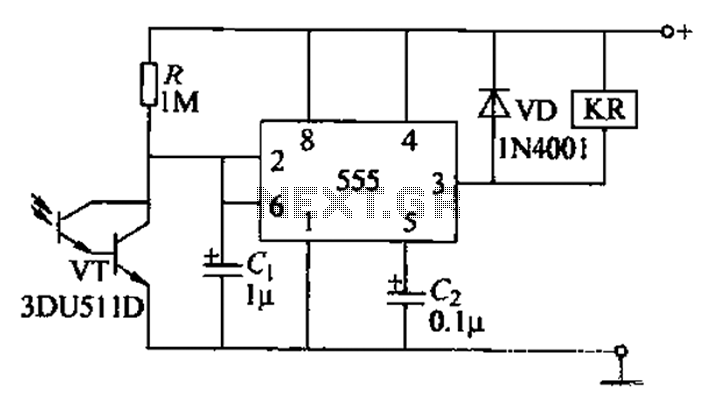
Simple Metal Detector Circuit
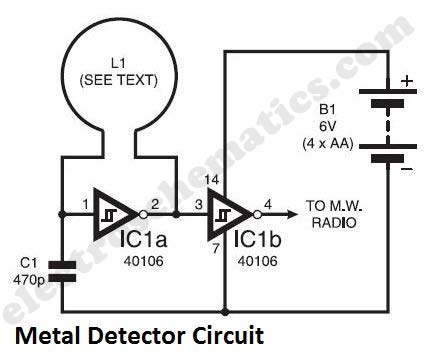
The metal detector circuit presented here exemplifies simplicity while demonstrating effective functionality. It utilizes a single 40106 hex Schmitt inverter IC, a capacitor, a search coil, and batteries. A connection from IC1b pin 4 must be made to a medium wave radio aerial or wrapped around the radio. This configuration allows it to operate similarly to handheld metal detectors. The circuit achieves a respectable beat frequency operation (BFO) range of up to 90mm for detecting a bottle cap. Notably, omitting capacitor C1 can extend the range to an impressive 150mm for a bottle cap, although this raises the frequency to over 4MHz, leading to potential instability. The circuit typically oscillates around 230kHz. Experimentation with the frequency can be conducted by adjusting the value of C1. To mitigate ground effects and capacitive coupling, a Faraday shield can be added and connected to 0V. The inductor's resistance to rapid voltage changes causes a slight delay in the charging of C1 as the logic level at IC1a pin 2 varies, establishing rapid oscillation detectable by a medium wave radio. Alterations in the inductance of the search coil due to the presence of metal result in frequency changes of the oscillator. Although 230kHz is outside the Medium Wave band, harmonics of this frequency can be clearly received by an MW radio. The construction of search coil L1 allows for significant tolerance and is not critical; the author utilized seventy turns of 30 SWG (0.315mm) enamelled copper wire on a 120mm diameter former. The metal detector is calibrated by tuning the MW radio to detect a whistle, with not all harmonics performing equally well, necessitating the identification of the most suitable one. The presence of metal will noticeably alter the whistle's tone. This design is not intended for industrial or security applications and does not compare to Loma or Eriez metal detection products; it serves as a portable, albeit not handheld, metal detector.
The metal detector circuit operates on the principles of beat frequency oscillation (BFO), where the frequency of the circuit is modulated by the presence of conductive materials. The core component of the circuit, the 40106 hex Schmitt inverter, provides the necessary logic level changes that drive the oscillation. The search coil, which acts as an inductor, is sensitive to changes in inductance caused by nearby metallic objects.
In practical terms, the search coil L1 can be designed with various specifications, but the suggested configuration of seventy turns of 30 SWG enamelled copper wire on a 120mm diameter former provides a good balance between sensitivity and ease of construction. The choice of wire gauge and number of turns directly influences the inductance and, consequently, the frequency response of the circuit.
The output signal from the circuit, which oscillates at approximately 230kHz, is not within the typical range of medium wave radio frequencies. However, the harmonics generated by this oscillation are detectable by an MW radio, allowing users to hear changes in frequency when metal is present. The tuning of the MW radio to a specific harmonic is essential for effective detection, as different harmonics may yield varying levels of sensitivity and clarity.
For enhanced performance, the addition of a Faraday shield can significantly improve the circuit's resilience to external electromagnetic interference. This shield serves to ground unwanted noise and stabilize the circuit's operation.
Overall, this metal detector circuit represents an accessible and educational project for electronics enthusiasts, demonstrating fundamental principles of inductance, oscillation, and frequency modulation while providing practical application in metal detection.The metal detector circuit shown here must represent the limits of simplicity for a metal detector, yet the design works surprisingly well. It uses just one 40106 hex Schmitt inverter IC, a capacitor and a search coil and of course the batteries.
A lead from IC1b pin 4 needs to be attached to a medium wave radio aerial, or it should be wrapped around the radio. It can be used even like those hand held metal detectors. As shown, the metal detector gives a respectable range for beat frequency operation (bfo) up to 90mm for a bottle-top. In fact, for the ultimate in simplicity, capacitor C1 may be omitted. In this way the author achieved am amazing 150mm range for the bottle-top. However, with the frequency then being raised to more than 4MHz, instability becomes a significant problem.
As shown, the circuit oscillates at around 230kHz. One may also experiment with the frequency by changing the value of C1. A Faraday shield may be added to reduce ground effect and capacitive coupling, and this is wired to 0V. Since the inductor resists rapid changes voltage, the charging of C1 is slightly delayed as the logic level at IC1a pin 2 changes.
This sets up a rapid oscillation, which is picked up by a MW radio. Any changes in the inductance of the search coil (through the presence of metal) bring about a change to the oscillator frequency. Although 230kHz is out of range of the Medium Wave band, an MW radio will clearly pick up harmonics of this frequency.
The making of search coil L1 allows a lot of room for error and is far from critical. The author used seventy turns 30 s. w. g. (0, 315mm) enamelled copper wire on a 120mm diameter former. The metal detector is set up by tuning the MW radio to pick up a whistle. Not every such harmonic works well, and the most suitable one needs to be found. The presence of metal will clearly change the tone of the whistle. This is not an industrial or security metal detector and is not even close to loma or eriez metal detection products. It`s just a portable but not a hand held metal detector. 🔗 External reference
The metal detector circuit operates on the principles of beat frequency oscillation (BFO), where the frequency of the circuit is modulated by the presence of conductive materials. The core component of the circuit, the 40106 hex Schmitt inverter, provides the necessary logic level changes that drive the oscillation. The search coil, which acts as an inductor, is sensitive to changes in inductance caused by nearby metallic objects.
In practical terms, the search coil L1 can be designed with various specifications, but the suggested configuration of seventy turns of 30 SWG enamelled copper wire on a 120mm diameter former provides a good balance between sensitivity and ease of construction. The choice of wire gauge and number of turns directly influences the inductance and, consequently, the frequency response of the circuit.
The output signal from the circuit, which oscillates at approximately 230kHz, is not within the typical range of medium wave radio frequencies. However, the harmonics generated by this oscillation are detectable by an MW radio, allowing users to hear changes in frequency when metal is present. The tuning of the MW radio to a specific harmonic is essential for effective detection, as different harmonics may yield varying levels of sensitivity and clarity.
For enhanced performance, the addition of a Faraday shield can significantly improve the circuit's resilience to external electromagnetic interference. This shield serves to ground unwanted noise and stabilize the circuit's operation.
Overall, this metal detector circuit represents an accessible and educational project for electronics enthusiasts, demonstrating fundamental principles of inductance, oscillation, and frequency modulation while providing practical application in metal detection.The metal detector circuit shown here must represent the limits of simplicity for a metal detector, yet the design works surprisingly well. It uses just one 40106 hex Schmitt inverter IC, a capacitor and a search coil and of course the batteries.
A lead from IC1b pin 4 needs to be attached to a medium wave radio aerial, or it should be wrapped around the radio. It can be used even like those hand held metal detectors. As shown, the metal detector gives a respectable range for beat frequency operation (bfo) up to 90mm for a bottle-top. In fact, for the ultimate in simplicity, capacitor C1 may be omitted. In this way the author achieved am amazing 150mm range for the bottle-top. However, with the frequency then being raised to more than 4MHz, instability becomes a significant problem.
As shown, the circuit oscillates at around 230kHz. One may also experiment with the frequency by changing the value of C1. A Faraday shield may be added to reduce ground effect and capacitive coupling, and this is wired to 0V. Since the inductor resists rapid changes voltage, the charging of C1 is slightly delayed as the logic level at IC1a pin 2 changes.
This sets up a rapid oscillation, which is picked up by a MW radio. Any changes in the inductance of the search coil (through the presence of metal) bring about a change to the oscillator frequency. Although 230kHz is out of range of the Medium Wave band, an MW radio will clearly pick up harmonics of this frequency.
The making of search coil L1 allows a lot of room for error and is far from critical. The author used seventy turns 30 s. w. g. (0, 315mm) enamelled copper wire on a 120mm diameter former. The metal detector is set up by tuning the MW radio to pick up a whistle. Not every such harmonic works well, and the most suitable one needs to be found. The presence of metal will clearly change the tone of the whistle. This is not an industrial or security metal detector and is not even close to loma or eriez metal detection products. It`s just a portable but not a hand held metal detector. 🔗 External reference
Warning: include(partials/cookie-banner.php): Failed to open stream: Permission denied in /var/www/html/nextgr/view-circuit.php on line 713
Warning: include(): Failed opening 'partials/cookie-banner.php' for inclusion (include_path='.:/usr/share/php') in /var/www/html/nextgr/view-circuit.php on line 713
